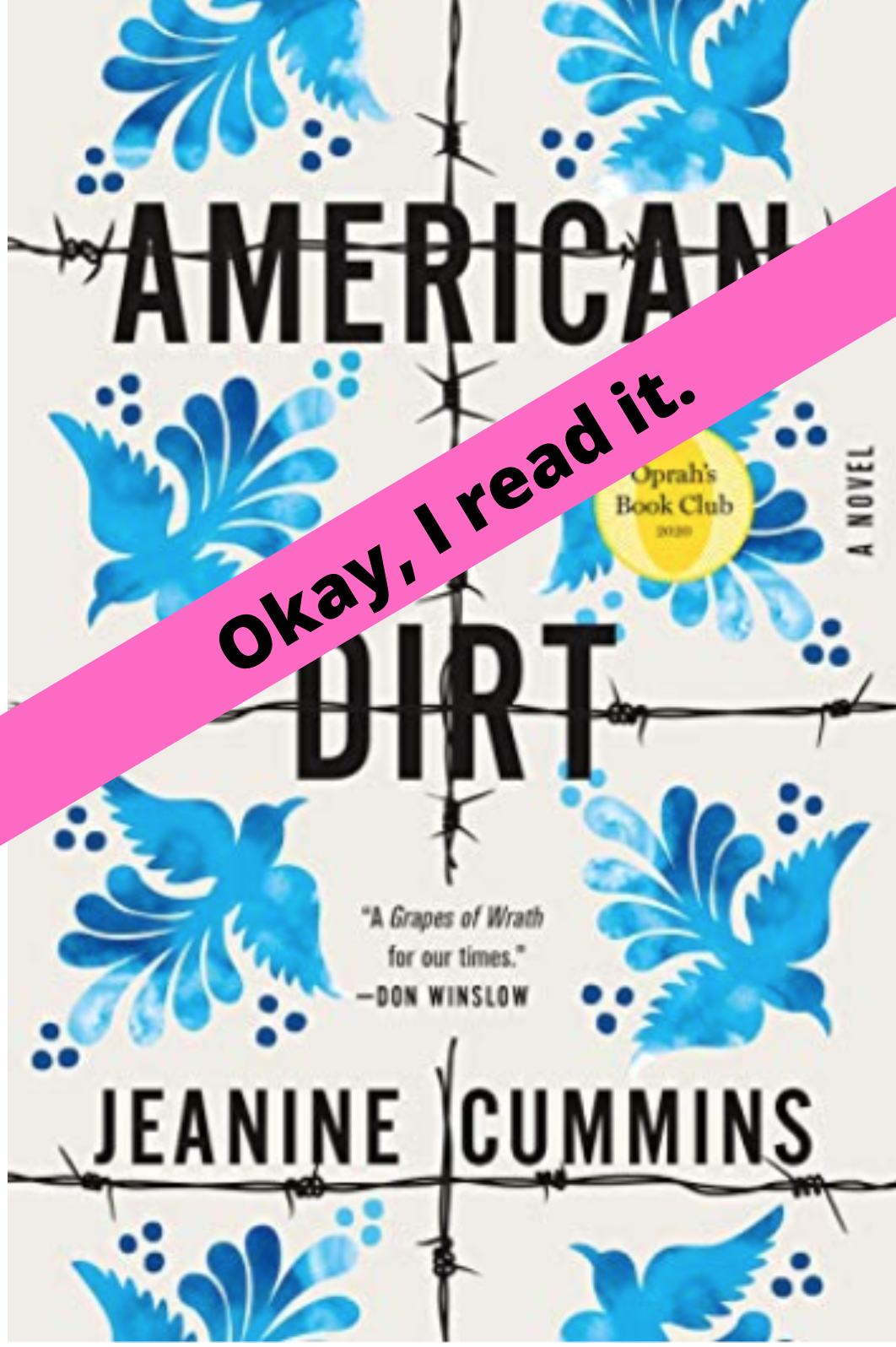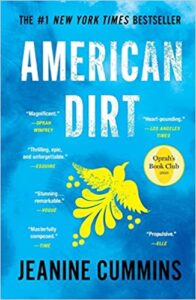(If it’s easier, you can also see/listen to me read this review on YouTube.)
SPOILERS BE HERE.
Three weeks ago I got an email announcing a new book club for women over 50, and the first novel they were going to read was Jeanine Cummins’American Dirt. The novel focuses on a Mexican woman’s journey from her home in Acapulco to the U.S, crossing without papers in extremely dangrous ways. Then I read about the book’s big controversy. Latinos were angry about the red carpet treatment given to this book written by a white woman because Mexican Americans telling similar stories don’t get nearly as much attention from publishers. The most scathing review was written by Myriam Gurba (and I urge you to read it). I would usually pass on a book like this.
Why I decided to read it
1. I wanted to be part of the new book club’s discussion to make sure at least one Latina was there.
2. Sandra Cisneros, one of the most well-respected Mexican American writers ever, endorsed American Dirt and stands by it. On NPR’s Latino USA, she said it could reach an audience her books couldn’t. I wanted to see what she meant by that.
3. I decided that rather than critically dog-pile on this book without reading it, it would be fairer to read it first and then dog-pile.
4. Some of us Latinos have to watch what white people are writing about us. By reading this 441-page novel, I’m taking one for the team. But it’s not so bad because I read fast and have two degrees in literature (I almost did my dissertation on Mexican American women authors, but instead chose to flee academia).
Why the book is perfect
American Dirt is a fast read. There’s little to slow a reader down such as philosophical views of humanity, deep poetic language, long pages of descriptions, reflections that make a reader stop and think about herself/himself, etc.
It’s also a fast read because it has the structure of a thriller. In the first chapter the main characters start running from the men who want to kill them and they don’t stop until the end of the book. Cummins created a character who has to cross the Mexic0-U.S. border because she’s being hunted by a drug cartel, not because she can’t earn a living in Mexico. That choice puts the focus on action and danger, not character development. It leads to scenes of violence instead of the pain of not being able to support a family.
In this way it’s different from every other book on the migrant experience I’ve read. Those books show people who come to the U.S. simply to earn a living. There’s no high adventure to it. Those stories show the underclass, motivated purely by the need for food and shelter. The plotlines don’t move quickly and they require the reader to see life through the eyes of migrants who ended up in poverty through circumstances beyond their control.
In contrast, American Dirt works very well as a fun, suspense-thriller for non-Latinos. Mexico is an exotic backdrop for a main character they can easily identify with. Lydia is a privileged, well-off, white Mexican who knows nothing about the migrant experience until she has to enter it. Thus American Dirt doesn’t require readers to step into the shoes of the desperate and impoverished. It only has us step into the shoes of a wealthy, white, Mexican woman who’s witnessing the lives of the desperate and impoverished.
White, middle-class Americans can identify with Lydia, an unusual immigrant who takes plenty of cash with her when she and her son flee their home and who’s able to access even more money later with an ATM card. When la migra stops the group of migrants she travels with, Lydia is able to prove her Mexican citizenship and walk away. Like many non-Latino Americans, Lydia sees migrants as sad, unfortunate people who need help.
This must be what Cisneros meant by saying that this novel can go where, for example, her books can’t. The typical white, middle-class and upper-middle class American reader isn’t likely to read books by Latinos and Latino Americans because those books don’t often make it to the end cap in the bookstore or Amazon Prime First Reads. But this one will. It has. It’s on book club lists across the country. It’s already sold its movie rights because it has a white, privileged main character Americans can identify with and it focuses on action instead of a look into the socioeconomic realities that create immigrants.
But the reason for its success isn’t that it was written by a white woman. It’s that this story doesn’t threaten American readers (some would say I’m splitting hairs, but I stand by my statement).
Cummins began researching this book in 2013 and finished drafting it in 2017. Even though immigration has increasingly been a political focus, her book has no political lens at all. It makes no comment on U.S. immigration policy, racism, asylum laws, the state of relations between Mexico and the U.S. or the intwined economies of the two countries. Because Cummins’ main character isn’t a migrant worker driven by economic need, Cummins sidesteps making any criticism at all of U.S. impact on the Mexican economy.
The absence of any such criticism is part of what makes this novel so palatable to Americans who aren’t Latino and so enraging to Latinos. Americans can read the whole thing without once considering where they fit into the picture. American Dirt contains no references to American exploitation of migrant labor, the American hunger for drugs or American prejudice against the people they depend on to keep their country functioning.
 |
| Jeanine Cummins Photograph: Heather Sten/The New York Times |
I once had an English professor who criticized a certain work by comparing it to a brick falling on a kitten: sad, but meaningless. Similarly, American Dirt tells a disturbing story (with a happy ending — WTH?), but doesn’t give the context that would make it a real contribution to the American discussion of immigration. Cummins has repeatedly said she wanted to make such a contribution, and I guess she did, but there’s no way this book will have any real effect.
I anticipate that “I read American Dirt” could become like “I voted for Obama.” White, non-Latino Americans will buy the book to show they’re not prejudiced, they’re making a difference, and they like Mexicans. Kudos to Jeanine Cummins who has given whites another way to feel good about themselves.
Why the book is flawed
In all the controversy, many have urged us to read this book and evaluate it on its own merits, as a piece of literature. Okay, done.
While the book reads easily, like a suspenseful page-turner, there were things that pulled me out of the story. For many pages at the beginning, the close narrator shows things through Lydia’s point of view, then switches to her son Luca’s point of view. Cummins does this throughout the novel and it feels clumsy every time. The only way you can tell the viewpoint has changed is that the narration stops referring to “Lydia” and starts referring to “Mami.”
The narration gets more jarring when it suddenly jumps from Lydia or Luca’s viewpoint to someone else’s, and at yet other times the narrator suddenly becomes omniscient. If the book had stayed omnisicient all the way through, these changes in viewpoint would have been fine. If it had stuck to either Lydia or Luca’s viewpoint that would have been fine. What it ends up doing is bewildering. Sometimes I don’t know through whose eyes we’re supposed to be looking.
The author and editor also made odd choices about using Spanish. Sometimes a Spanish word or phrase is translated. Sometimes it’s not. Sometimes a Spanish word or phrase is in italics. Sometimes it’s not. It’s distracting. Worse, someone made the decision to refer to the United States as “Estados Unidos” without “los” in front of it. From the book: “The current group will fly home to Estados Unidos Wednesday” and “We’re going to Estados Unidos.” Why? Why didn’t they use the phrase “los Estados Unidos” which is how Spanish speakers actually talk? This bugged me every time I came across it!
I also noticed that some of the cultural references were off. Cummins’ reference to freight tracks that stretched out “across the Mexican landscape like a beanstalk migrants climb” is a reference to an English tale that’s well known to Americans. Lydia has a memory of October 24 being “exactly one week before el Día de los Muertos.” Actually, October 24 is exactly one week before Halloween. Día de los muertos is at the beginning of November.
Lydia and Luca end up being led by a coyote whose group includes a PhD student (Nicolás) and a middle-class, well-heeled, middle-aged woman (Marisol) who was recently deported after living in San Diego for years. Because Lydia has lived a wealthy, privileged life, they have to explain some things to her.
‘What is it?’ This is Lydia.
‘A routine immigration check-in?’ Marisol asks.
‘Yes.”
‘It’s an appointment, usually once a year, where I have to go and check in with an ICE officer,’ Marisol explains. ‘So they can review my case.’
‘But what for? So you can get your papers?’
‘No, just so they can keep tabs on me,’ Marisol says.
Lydia is confused. ‘And ICE is…?’
‘Immigration and Customs Enforcement.’ Nicolás fills in the acronym. ‘I never went to a single one of my check-ins.’
‘I guess it doesn’t matter now,’ Marisol says. ‘We both ended up in the same boat.’
I wonder if Cummins gave so many speaking lines to Marisol and Nicolás because she wanted to show white America that people like them — people with wealth and advanced education — also cross the border. Not to put too fine a point on it, but I wonder if she wanted to show that Mexican immigrants are “good” people, too.
All novelists strive to show readers the story instead of telling them about it, and Cummins does lots of showing, but she also does too much telling. Soon after the previous quotation, the questions and answers take on the feel of an after school special. A few pages later, Marisol describes the detention center she was in.
‘So many mothers in there without their daughters, without their children.’ Her eyes fall to the floor and her voice drops to a whisper, but they can all hear it in the hushed room. ‘Most of those women were separated from their children at the border,’ she says. ‘When they were caught coming in. Some had babies taken right out of their arms. I thought those women would lose their minds. They didn’t even know where their children were – some of them were too young to talk, too young to remember their names.’
It’s as if Cummins wanted to include all the important parts of the immigrant experience, but didn’t have time/room to show everything. She uses this short-hand of having characters tell their stories throughout the book, like a New World Canterbury Tales. Furthermore, she seems to have taken at least one of these stories from the book of a Mexican American author.
The effect of minor characters telling stories distances readers from the raw pain of these experiences and keeps us from engaging deeply with anyone. It’s why Cummins’ novel has been called trauma porn: instead of having readers fully identify with characters and feel their pain with them, this novel gives fleeting snapshots of human devastation that people can consume without deeply engaging with it.
In all, American Dirt (which never makes clear why that’s the title) doesn’t stand well on its own merits. The writing isn’t strong, the editing is bizarre, and I think critics are fair to say it’s another instance of someone taking various Mexican elements, reconstituting them and presenting them to the American public in a form that’s easy for them to swallow. One critic compares it to Taco Bell.
American Dirt reads like a thriller that will make a good action flick, but it doesn’t give us full characters or allow readers to truly understand their lives. With Lydia as an American stand-in, Cummins takes us on a tour of what it’s like to cross the Mexico-U.S. border without papers. It’s as if her goal was only to get American readers to repeat, “I didn’t know that” and “Oh, my God. That’s awful.” It’s spectacle without historical or political context, and considering how much is at stake on the border today, it’s clear why Cummins’ novel infuriates so many.
Maybe read this next: What should I read instead of American Dirt?
UPDATE 21 Feb 2023: The movie rights to American Dirt were sold in 2020, but we haven’t seen that movie come out yet, have we? Also, the comparison to The Grapes of Wrath (for god’s sake) that was on the cover of the first edition of this book, has been removed. Now it looks like this:





This post details so much more info than other people, and it’s immensly useful to me. Will follow you to read more writing from you! is it okay to share this?
Thank you for your post. I really enjoyed reading it, especially because it addressed my issue. It helped me a lot and I hope it will also help others.
Thanks for your help and for writing this post. It’s been great.
Your articles are very helpful to me. May I request more information?
Thank you for writing this article. I appreciate the subject too.
ckfugq
Seriela, what video would you have linked my video on? What's your YouTube channel?
In 1991 I planned to write my dissertation on images of beauty in literature by Mexican American women and Latino rap culture (1990 was the dawn of Latino rap with Kid Frost, Gerardo and Mellow Man Ace). The authors would have been Ana Castillo, Sandra Cisneros and Gloria Anzaldúa. What's "tbr?"
¡Bravo! ?????? I only wish I had seen your video before so I could link it on mine. I will definitely do so in my next one as well as link your blog. I would appreciate knowing the names of the Mexican authors you were considering before you left academia. I have Elena Poniatowska on my tbr (in Spanish), but would like to know about more – be they mexicanas que escriben en español, chicanas, second generation. WHATEVER. Your video and this blog give me life. Mil gracias. (Now off to the laptop to subscribe to the blog.)
Ccseth – I KNOW! There is so much more to say about this book than I put in this review. One of the first things that occurred to me when I heard about it was, "There better be a damn good reason for it to be called American DIRT." But the phrase "American dirt" only occurs once in the book:
"She sticks her hand through the fence and wiggles her fingers on the other side. Her fingers are in el norte. She spits through the fence. Only to leave a piece of herself there on American dirt."
I think a lot of what's wrong with the book were probably the choices of the editor. The weird Spanish, the weird title, the weird use of italics, the awful pull-quote that's on the cover of the book, the cover design, and of course the promotion and rollout. It's all bad. But I only hold Cummins accountable for her actual writing and her decision to write this book at all. She has said many times that she didn't think it was her place, but made the decision to go ahead. The woman should have listened to her gut.
And thanks for watching the video!
Hi! So I watched the video 🙂 and I was wondering about the title not being explained, and that is "scary" because is the author referring to immigrants as "american dirt"… or translated "dirt" literally from "tierra" of "tierra Americana"? Which I don't know what is worse…
Hi, Mary. Thanks for the compliment! You have to be on the desktop version of my blog to see the scroll on the right side of the page. Sign up where it says "Follow by email" and you'll get my posts in your email inbox. Thanks for wanting to follow.
Great review. I also forced myself to read the book. The plot makes no sense. The head of the drug cartel is an avid reader who frequents boutique book stores just to talk to someone about books. Ha ha ha ha! Her writing also sucks. It's trauma porn. The depictions of 14 year old "brown girls too pretty for their own good" getting raped is gross. Cummins (no god damn relation!) has daughters the same age.
How can we follow your blog? I don't see the link. Thanks.
Well, Meridith, I went on Amazon.com to leave a review, even though I didn't buy the book on Amazon. Usually that doesn't matter, but today I got this message:
Amazon has noticed unusual reviewing activity on this product. Due to this activity, we have limited this product to verified purchase reviews.
I'm not willing to spend $16.79 for the hardcover version of American Dirt, or $14.99 for the ebook, so I can't review it. I got this book on eBay as an ebook for 3 bucks and that's more than enough to spend on this exercise.
Um, considering that it takes between 10 and 15 minutes to read this review, I doubt it's practical for Amazon.com, but I'll post a shorter version. As far as recommendations go, it depends on whether you're looking for books on the Mexican migrant experience or novels about Mexican Americans born here or books about living close to the border, etc. One I haven't read yet, but that looks good is called I'm Not Your Perfect Mexican Daughter about a girl growing up in the U.S.
Wow, trauma porn. What a concept.
This review is amazing! You should post it on Amazon. I'm not quite sure how they prioritize customer reviews on there, but it would be wonderful if yours made it to the top of the list. I think your points and perspectives on this book are important and necessary.
Also, would you recommend any particular book to read in place of this novel? Maybe something that has been written by a Mexican person, even!